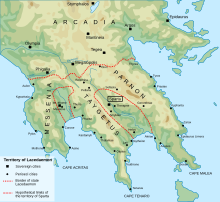Spartan hegemony
Spartan hegemony refers to the period of dominance by Sparta in Greek affairs from 404 to 371 BC. Even before this period the
History and rise to power

The Spartans had conquered the southern Peloponnese and incorporated the territory into the enlarged Sparta state. Spartan society functioned within three classes: homoioi or
Sparta's post Peloponnesian War regime
Sparta was divided over what to do about Athens itself. Lysander and King Agis were for total destruction as were Sparta's leading allies Corinth and Thebes. However, a more moderate faction led by Pausanias gained the upper hand. Athens was spared but her long walls and the fortifications of Piraeus were demolished. Lysander did manage to insert the significant condition that Athens recall her exiles.[4]: 129
The return of the exiles to Athens contributed to the political instability of Athens allowing Lysander to establish shortly the oligarchy that has come to be known as Thirty Tyrants, composed of men beholden to him.[4]: 129–130 The danger of so much power being in the hands of one person had become sufficiently clear that both King Agis and King Pausanias agreed that Lysander's wings needed to be clipped. The decarchies were declared abolished and Athens quickly benefited when Sparta permitted democracy to be restored at Athens.[4]: 130–131
Agesilaus and his campaigns
- The Campaigns
Agesilaus’ first campaign was one which trekked into the eastern Aegean and Persian territories via the
Remaining true to the Spartan ideals of austere living practices, Agesilaus rejected the gold saying “he would rather see it in his soldier’s hands than his own.[3]” Agesilaus did, however, remove his army into Phrygia, grateful for the death of Tissaphernes.
Agesilaus soon began another campaign into the western regions of the
In Greece, the Spartans under Agesilaus met the numerous rebelling poleis. Among the most important battles that the Spartans fought in this war was that of Coronea, which was fought against a coalition of Greeks but especially the Thebans. The Spartans sought the aid of the Persians, asking them to cut off their support of the Thebans, Corinthians and Athenians. The resulting Peace of Antalcidas, named for the Spartan who negotiated it, was established in 386 BC and resulted in Sparta's loss of its Asian territories.[8]
The Boeotian War
During the winter of 379/378 BC, a group of Theban exiles were able to sneak into the city and, despite the 1500-strong Spartan garrison, succeed in liberating Thebes.
Sparta after hegemony
During the Spartan hegemony in Athens there is evidence of
The importance of Sparta in politics largely drops off after Sparta's defeat at Leuctra. Following Agesilaus’ death in 360 BC,
References
- ^ a b c d Jones, Nicholas F. Politics and Society in Ancient Greece. Westport, CT: Prager, 2008
- ^ a b c Archer, Melanie. The Spartans Alexandria, VA: PBS Home Video, 2003
- ^ a b c d e f g Plutarch. "Agesilaus." Lives of Plutarch. Trns. Bernadotte Perrin. Vol. 4. Cambridge, Massachusetts: Harvard University Press, 1959–67
- ^ ISBN 9781444360530.
- ^ ISBN 9781848322226.
- ^ Lambert, Stephen; Schuddeboom, Feyo; Osborne, Robin. "Epitaph of Dexileos, cavalryman killed in Corinthian war (394 BC)". Attic Inscriptions Online. Retrieved 31 December 2023.
- ^ Kagan, Donald. "Corinthian Politics and the Revolution of 392 B.C." Historia: Zeitschrift für Alte Geschichte. 11.4 (October 1962): 447–457.
- ^ Xenophon. Hellenica. New York: Penguin Books, 1978.
- ^ ISBN 0801835054.
- ^ Balot, Ryan K. Greek Political Thought. Malden, MA: Blackwell, 2006.
External links
 Media related to Spartan hegemony at Wikimedia Commons
Media related to Spartan hegemony at Wikimedia Commons
